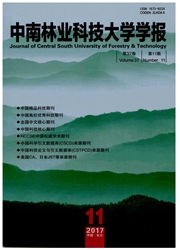

 中文摘要:
中文摘要:
以2009年秋天采自湖北利川小河的水杉种子为研究对象,测定了水杉种子的千粒重、饱满度和发芽率,并研究了遮荫对水杉种子出苗率的影响,同时对水杉田间人工育苗和不同立地上的自然出苗率进行了比对。通过上述实验,对水杉天然更新能力差的原因从种苗学角度上进行了分析。结果表明:水杉种子空粒率很高,约为85%,种子的绝对发芽率大于68%。由于原产地水杉结实量很大,所以水杉种子仍具有较强的繁殖能力,繁殖能力不是导致水杉天然更新能力差的主要原因。同时,还发现光照条件对水杉种子发芽率也无明显影响,而整地、覆土等对水杉种子出苗率和出苗速度影响显著。通过适当的人工育苗措施,水杉种子有较高的成苗数。研究发现,水杉天然更新能力差的主要原因是在出苗环节上。通过分析,我们提出生态保护和采用实生苗造林是解除水杉濒危状况的重要举措。本研究从种苗学角度,为了解水杉的濒危机制提供了实验依据。
 英文摘要:
英文摘要:
Cones of Metasequoia glyptostroboides were collected from Xiaohe Lichuan in Hubei province in the autumn of 2009, and the obtained seeds were used to measure parameters included: 1000-grain mass, plumpness, germination rate, etc. The effects of different shading treatments on seed germination rate were investigated. Besides, the seedling emergence rates between under the manual operations and the natural conditions, different site conditions were compared. Based on the testing data, the causes led to the poor natural regeneration ability of Metasequoia glyptostroboides were analyzed. The results reveal that the empty grains percentage of Metasequoia glyptostroboides seeds was very high, accounting for about 85%, but the germination ratio of plump seeds was quite high, being more than 68%. Since Metasequoia glyptostroboides possessed very high seed setting rate, this plant species had relatively high regeneration ability. Regeneration ability was not the major causes leading to its poor natural regeneration. Meanwhile, light condition also didn’t obviously affect the seed germination of Metasequoia glyptostroboides. However, land- preparation and covering soil affected the seed germination rate and germination speed significantly. By artificial seedling cultural measures, Metasequoia glyptostroboides could achieve high seedling emergence rate. The outcomes of the study indicate that the poor natural regeneration ability for Metasequoia glyptostroboides was mainly related to seedling emergence procedures. The ecological protection and afforastation by seeds for Metasequoia glyptostroboides are the important measures to relieve this plant species from the endanger condition. In the view of seed-seedling, the study provides a basin for better understanding the mechanisms that led to endanger of Metasequoia glyptostroboides.
 同期刊论文项目
同期刊论文项目
 同项目期刊论文
同项目期刊论文
 期刊信息
期刊信息
